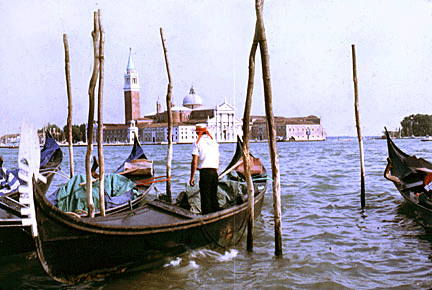 I got my first view of the
Veneto, the Venetian Lagoon, as I stepped out of the bustling train
station at the mainland end of the Grand Canal. Venice, "La Serenissima"—the
"Most Serene Republic" which Truman Capote once said is “like eating a
box of chocolate liquers at one go.” At other train stations throughout
Europe, I would have been greeted by a line of taxis, painted in a
variety of colors and patterns. But in the island city of Venice, all I
heard was the chug, chug of motorboats and the horns of the vaporetti,
the bus-taxis of this watery world. It was then I knew this was a city
like no other. I got my first view of the
Veneto, the Venetian Lagoon, as I stepped out of the bustling train
station at the mainland end of the Grand Canal. Venice, "La Serenissima"—the
"Most Serene Republic" which Truman Capote once said is “like eating a
box of chocolate liquers at one go.” At other train stations throughout
Europe, I would have been greeted by a line of taxis, painted in a
variety of colors and patterns. But in the island city of Venice, all I
heard was the chug, chug of motorboats and the horns of the vaporetti,
the bus-taxis of this watery world. It was then I knew this was a city
like no other.
Early in the morning, a mist shrouds the Grand Canal and the city
beyond. Venice is unlike any city on Earth—a medieval Disneyland filled
with the spirits of merchants and boatmen. As the packed Vaporetto
Number One chugged down the Canal, I felt as if I were being transported
into another world. Little did I know that my first impression would
turn out to be true.
 The Veneti, who by the 13th century had achieved so much in terms of
social values, lived on an ill-defined triangle of land formed by the
River Po, the Alps, and the Adriatic Sea. Set in a seaside lagoon dotted
with small islands, Venice appears to float upon the water like a
magical mirage, a living museum to its former glories. The Veneti, who by the 13th century had achieved so much in terms of
social values, lived on an ill-defined triangle of land formed by the
River Po, the Alps, and the Adriatic Sea. Set in a seaside lagoon dotted
with small islands, Venice appears to float upon the water like a
magical mirage, a living museum to its former glories.
It rose to greatness during the Renaissance of the 15th century when its
merchants traded the length and breadth of the Mediterranean. After the
fall of Constantinople, the Venetian galleys returned home laden with
riches—gold, spices, silks, brocades and works of art—including the
golden horses of San Marco, caught at full gallop with an unrestrainable
forward motion, now the symbol of the city’s liberty.
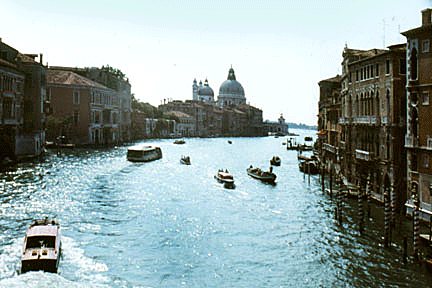 As a result of its geographical position and the way it developed over
the centuries, the art and culture of Venice remained Byzantine in
style, as I came to see in the Basilica of San Marco, one of 107
churches whose ringing bells still regulate community life. As a result of its geographical position and the way it developed over
the centuries, the art and culture of Venice remained Byzantine in
style, as I came to see in the Basilica of San Marco, one of 107
churches whose ringing bells still regulate community life.
Motorized vaporetti, gondolas, and boats of all sizes glide under 400
bridges along its canals taking people and goods from dock to dock. A
long motorboat bearing a coffin floated gracefully by in serene
majesty—like a scene out of Death in Venice. Relatives of the dearly
departed stood on either side of it in solemn meditation. Smaller boats
sped by on either side like cars passing on a four-lane highway.
My destination was the home of Signoura Reggio, where I would be living
while studying photography. I had no idea where she lived, only that it
was near Piazza San Marco.
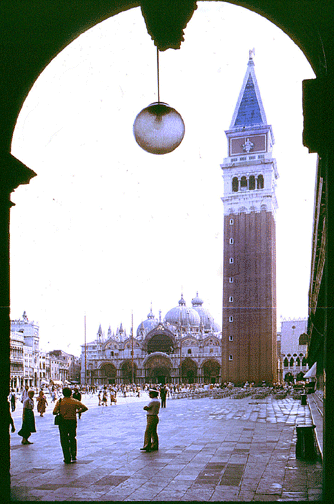 Over the next few weeks I literally lost myself in Venice. In fact, I
got lost many times. Three thousand alleys and thoroughfares make up the
labyrinth of Venice, all in a tiny four-square-mile area. And I believe
I must have explored every one of them during the time I was there.
Major lanes would end in a maze of little alleyways. It was only after I
realized that there were red arrows painted on the corners of buildings
leading me out the warren of side streets that I finally learned to find
my way across town. Over the next few weeks I literally lost myself in Venice. In fact, I
got lost many times. Three thousand alleys and thoroughfares make up the
labyrinth of Venice, all in a tiny four-square-mile area. And I believe
I must have explored every one of them during the time I was there.
Major lanes would end in a maze of little alleyways. It was only after I
realized that there were red arrows painted on the corners of buildings
leading me out the warren of side streets that I finally learned to find
my way across town.
I soon learned that the area around the Rialto Bridge—Venice’s most
photographed— was the center of city life and home to the bustling City
Market, best seen as the sun creeps up over the horizon. Boats of all
sizes, filled with a myriad of vegetables and fruits, jockeyed for
position. After wandering around the market, I headed over the bridge,
stopping for an espresso at a neighborhood stand-up coffee bar with all
the people headed to work. On my way, I stopped to watch a florist
prepare a funereal spray in the open air on the Piazza Academia.
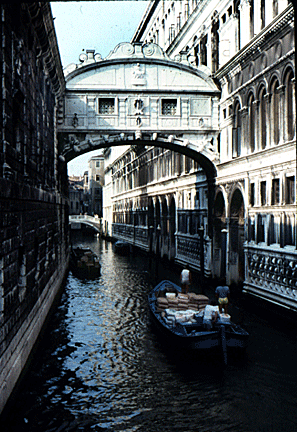 Every morning, on my way to the Palazzo Fortuny, a grand old mansion
where I was studying photography, I had to pass through the Piazza San
Marco. At that early hour, the only people in the square were other like
me on their way to school or work. Flocks of pigeons eagerly await the
crowds of tourists that would soon gather in the open-air cafes. Every morning, on my way to the Palazzo Fortuny, a grand old mansion
where I was studying photography, I had to pass through the Piazza San
Marco. At that early hour, the only people in the square were other like
me on their way to school or work. Flocks of pigeons eagerly await the
crowds of tourists that would soon gather in the open-air cafes.
Several days during the week, my class schedule allowed me time to
explore some of Venice’s most historic spots. I began at the Gothic il
Palazzo dei Dogi, the Palace of the Doges, a symbol of Venice’s beauty,
perched at the far end of Piazza San Marco. As part of my exploration of
the palace and the Basilica of San Marco, I climbed the bell tower to
get a panoramic view of the square and the city.
Another afternoon, after following a gondolier to a local café for a
plate of pasta, I set off in a vaperetto to visit the islands of the
Veneto—the church of Torcello, the lace makers of Burano, the glass
blowers of Murano. On my return, I admired l’Arsenale, where Venetian
ships had been built for centuries. And as the sun settled behind grand
palazzos filled with art, I treated myself to smooth Italian ice cream
along the Zattere waterfront as the lights flickered in the water of the
Guidecca Canal.
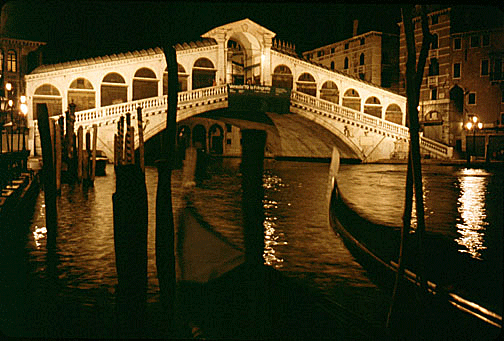 Venice is at its most magical after dark, when the reflections in the
Grand Canal sparkle like thousands of loose diamonds floating on the
water. Off in the distance the music of an accordion echoes off the
buildings as a fleet of serenading gondoliers make their way up the
Canal, candle lanterns lighting their way. As I walked the darkened
alleys, I would come across a quiet one lit only by one bare light bulb
hanging overhead. Venice is at its most magical after dark, when the reflections in the
Grand Canal sparkle like thousands of loose diamonds floating on the
water. Off in the distance the music of an accordion echoes off the
buildings as a fleet of serenading gondoliers make their way up the
Canal, candle lanterns lighting their way. As I walked the darkened
alleys, I would come across a quiet one lit only by one bare light bulb
hanging overhead.
Along the canals, floodlit churches stand like facades of scenery
waiting for a grand opera to begin. In fact, all of Venice is like a
floating stage on which is enacted an historical drama of immense
proportions.
Saturdays were my favorite. It’s as if Venetians patiently awaited the
coming of the end of the week, so they could relax a bit from the daily
hassle of tourists. Vaporetti were comfortably empty. Women made their
way to Isola di San Michele, housing the city’s cemetery, with bouquets
of flowers for the tombs of their departed loved ones.
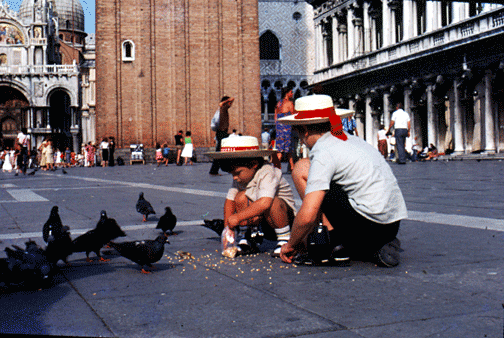 Even Piazza San Marco was relatively barren. A few scattered tour
groups, the pigeon feed hawkers, and photographers milled around its
fringes. Though the sun was bright, it didn’t seem so. People could even
read newspapers on the Circolare Vaporetto to the island of Murano in
the Lagoon and talk small talk with their friends. The staff of cafes
and restaurants took the opportunity to clean up, washing down and
scrubbing the tables and chairs as they prepared for yet another hectic
week. Even Piazza San Marco was relatively barren. A few scattered tour
groups, the pigeon feed hawkers, and photographers milled around its
fringes. Though the sun was bright, it didn’t seem so. People could even
read newspapers on the Circolare Vaporetto to the island of Murano in
the Lagoon and talk small talk with their friends. The staff of cafes
and restaurants took the opportunity to clean up, washing down and
scrubbing the tables and chairs as they prepared for yet another hectic
week.
I discovered that Venice deserved to be savored like fine wine in sips
rather than gulps. But, unfortunately, most people visit for the
day—scurrying around like mice in a maze, stroll around Piazza San
Marco, stop for a drink at Café Florian, and perhaps buy a small
Venetian glass sculpture. To most, that’s the sum of their Venetian
experience. I was so lucky to have stayed there for a while, immersing
myself in its rich tapestry of history.
< Back to
Travel Articles
Go to next article > |
